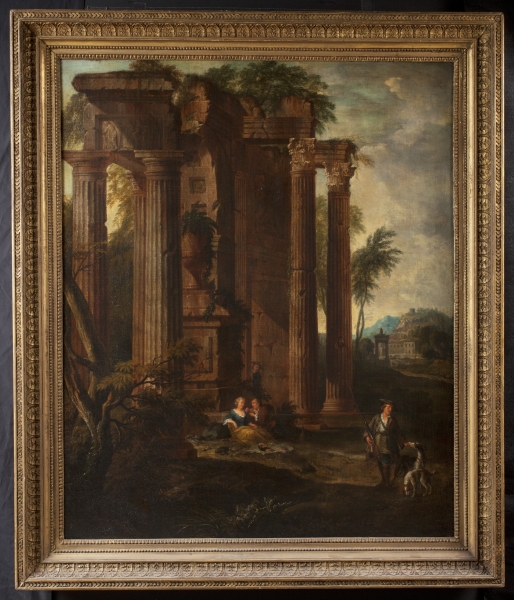· 16 ·
Framing the Interior:
The Entrepreneurial Career of John Doggett
RICHARD C. NYLANDER
John Doggett (fig.1) was one of more than a dozen looking-glass makers and picture framers who plied their trade in early nineteenth-century Boston. His name is one of the most recognized by furniture historians today, as indeed it was in his own time. In the many notices of auctions of household furnishings in the 1820s, the only looking-glass maker identified is Doggett or his firm, implying a mark of recognizable quality.1 The First Exhibition and Fair of the Massachusetts Charitable Mechanic Association, an organization he joined in 1804 and served as both trustee (1813–16) and vice president (1822), awarded a silver medal to the Doggett firm for the frames it exhibited, noting they were “decidedly the best work in the exhibition, being in handsome style, and of the best gilding. The large Mirror Frames, and one enclosing a picture by Fisher, are worthy of high commendation.”2
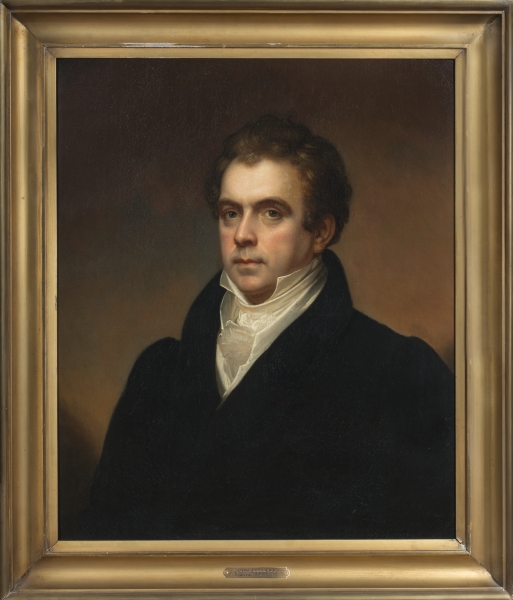
FIG. 1. Portrait of John Doggett, Rembrandt Peale (1778–1860), Boston, 1828. Oil on canvas; h 36, w 31 (including frame). Private collection. Photo, Gavin Ashworth. The current frame replaces the original shown in fig. 13 and probably dates from about 1943, when this painting and the companion picture of Doggett’s wife were sold at auction.
Doggett’s nearly fifty-year career witnessed changes in fashion as well as technology, new ways of marketing, economic highs and lows, and trade and tariff restrictions. He seems to have been a savvy businessman, always seeking the best price on materials and terms of credit from his suppliers, quick to observe trends and grasp the opportunity to capitalize on them, and willing to pursue several avenues to satisfy what he once called “the very peculiar and difficult to please” taste of Boston’s citizens.3
John Doggett’s early career in Roxbury, Massachusetts, is documented through his daybooks, in invoices at various manuscript collections, and by labeled looking glasses and picture frames. However, except for references to the American Kings, a series of lithographic copies of the Gilbert Stuart portraits of the American presidents that Doggett commissioned in 1822, and an occasional footnote about the frame of a particular portrait, little has been published about his business activities after the formation of John Doggett & Co. in 1810. The firm subsequently relocated to Boston, a move that took Doggett from a community of craftsmen and artisans into a growing center of artists and entrepreneurs.
EARLY YEARS IN ROXBURY
John Doggett was born in Dedham, Massachusetts, on September 15, 1780, the second of three children of Lieutenant Samuel Doggett and his wife, Elizabeth Badlam Doggett. He became an apprentice to his uncle Stephen Badlam, a looking-glass maker and cabinetmaker, on January 26, 1795, just four months shy of his fifteenth birthday.4 The Doggett genealogy refers to his early career only as a carver and gilder and repeats what must have been a family tradition—that he paid an English artisan $25 for instruction in gilding.5 Doggett also learned some cabinetmaking skills, and one of his earliest efforts is a painted and gilded pier table that according to family tradition he made for his sister in 1796 and that descended in her family (fig. 2).
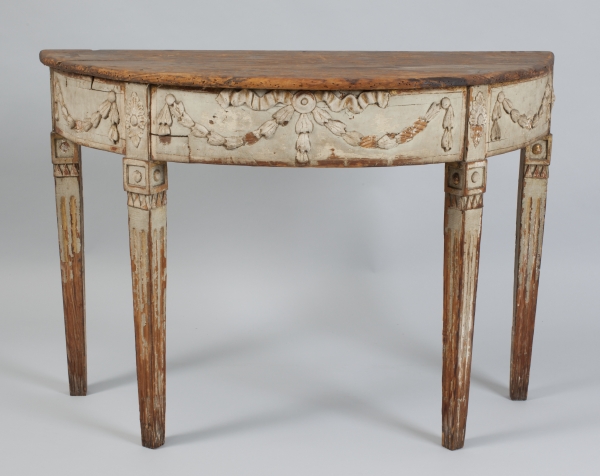
FIG. 2. Pier table, attributed to John Doggett (1780–1857), Roxbury, Mass., ca. 1796. White pine; h 30, w 41½, d 18. Historic New England; Museum purchase (1974.226). According to family tradition, Doggett made this table for his sister Betsy (1778–1850).
Two daybooks and about fifteen pieces with labels record Doggett’s early output. The first daybook is inscribed “John Doggett’s Book / Roxbury December 4th / 1802” and covers from that date until December 16, 1809. The second is inscribed “John Doggett’s / Day Book, / January 1st / 1810.” Although the latter continues with miscellaneous accounts into 1814, the systematic accounting system begun in the first volume ends in mid-July. This may indicate the date when Doggett formed John Doggett & Co., a partnership with Charles Miller and Samuel Sprague Williams. He had hired Williams in 1808 and Miller a year later, paying each $20 per month.6
In February 1803, Doggett records that John Ritto Penniman, a decorative painter who remained a lifelong friend, painted his shop sign, and in June of that year Doggett placed a notice in the Columbian Centinel informing “his Friends and the Public that he carries on the Looking-Glass and Picture Framing, in gilt and burnished Gold, in an elegant style, near Mr. SIMON WILLARD’S Clock Manufactory, in Roxbury-street.”7 In addition to carrying a “handsome assortment,” he advised prospective clients that he would exchange new looking glasses for old ones and make repairs. Three years later, Doggett refers to his establishment as “his Looking Glass & Picture Frame GILDING FACTORY” in a notice entitled “To the Patrons of the AMERICAN Artist.”8
Over the years, the Doggett daybooks have provided decorative arts scholars with a fascinating window into the interrelationships of the craftsmen in Roxbury, including his dealings with clockmakers Simon and Aaron Willard; other looking-glass makers, such as Paul Cermenati and his various partners; brothers Stillman and Edward Lothrop (who also apprenticed with Stephen Badlam); and a number of dealers with whom he placed looking glasses on commission. The account books document specific pieces that he provided to a range of wealthy clients, including Elizabeth Derby of Salem.9
The first daybook lists more than 250 looking glasses and looking-glass frames, ranging in size from 71 by 41 inches to as small as 10 by 8 inches. The majority were gilded but some were made of mahogany. Most entries give the name of the client and the size; it is unclear, however, if the dimensions are of the finished looking glass or those of the mirror plate (see, for example, the letters to James Maicher and Samuel Rodman discussed below).
To date, two different labels have been recorded on fourteen looking glasses and two framed pictures. Although it is sometimes thought that labels were affixed to pieces made for export, the two pictures—a framed elevation of an unidentified building, inscribed “Joseph Lovering” on the backboard, and a watercolor family register of the Howe and Richardson families—certainly were commissioned.10 Doggett used the simpler, and possibly earlier, of the two labels (fig. 3) for these items and for five looking glasses. The more elaborate label (fig. 4) is pasted only to the backboards of looking glasses and appears to have been copied from a girandole looking glass, which has accordingly been attributed to Doggett.11 The names of both the designer and the engraver are incorporated into the design. Printed just beneath the tail of the right-hand dolphin is “J R Penniman del,” and under the left tail is “S Harris Sc,” for the engraver Samuel Harris, who drowned in the Charles River in 1810.12
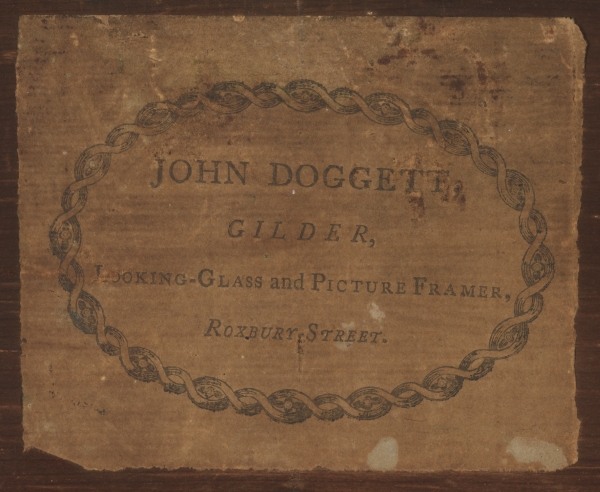
FIG. 3. Label of John Doggett on the reverse of an architectural drawing, frame by John Doggett, Roxbury, Mass., ca. 1810. White pine; h 17, w 23½ (frame). Historic New England; Museum purchase (2003.34).
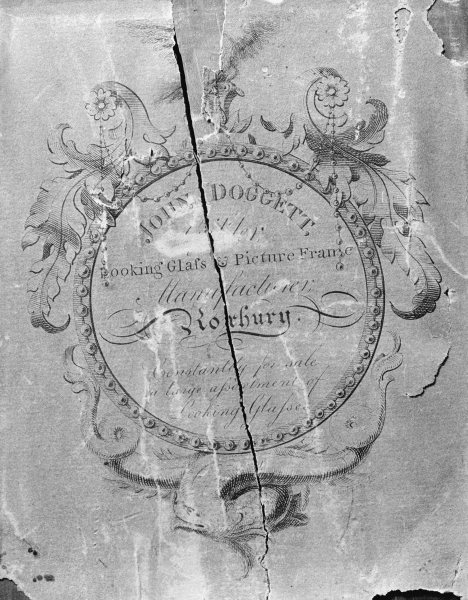
FIG. 4. Label of John Doggett on the reverse of a looking glass, drawn by John Ritto Penniman (1782–1841). Looking glass, John Doggett, Roxbury, Mass., 1805–10. White pine; h 35, w 22¼. Metropolitan Museum of Art; Gift of Mrs. Russell Sage, 1909 (10.125.377).
With the exception of one oval glass, the labeled looking glasses follow the prevailing style of the federal period: a frame with pillars on each side supports a projecting cornice with or without gilt balls, and a divider separates the mirror plate from a decorative tablet above (fig. 5). Only one tablet is embellished with composition ornament; all the others are reverse-painted glass panels, usually with a scene on a white background or surrounded by a white mat. The two most elaborate tablets depict allegorical figures on either side of a foundering ship and are signed “PAINTED by / John Ritto Penniman / Boston / 1803.”13
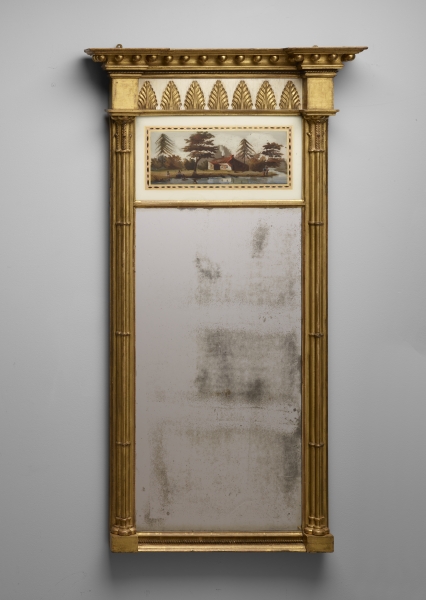
FIG. 5. Looking glass, John Doggett, Roxbury, Mass., 1805–10. White pine; h 56⅞, w 31, d 5⅝. Dallas Museum of Art; The Faith P. and Charles L. Bybee Collection, gift of Mrs. Jake L. Hamon (1985.B.40.1).
In January 1815, the Columbian Centinel announced the dissolution the previous month of the “Firm known as JOHN DOGGETT & CO.,” the partnership Doggett had formed with Charles Miller and Samuel Williams. The same paper notified customers that Samuel Williams and John Doggett would continue under the name Doggett & Williams. Two years later, they took in Doggett’s younger brother Samuel and returned to the name John Doggett & Co.
THE MOVE TO BOSTON
In 1818, John Doggett & Co. moved to Boston and established the Looking Glass Warehouse at 28 Market Street; the factory remained in Roxbury.14 In addition to manufacturing looking glasses, the firm imported ready-made examples as well as a huge quantity of glass plates for its own use and for sale to others. In late 1818, it advertised “1 pair large Pier Glasses, presumed to be the richest and most elegant ever imported into Boston.”15 A notice in 1820 lists thirty specific sizes, from 80 by 46 inches to 40 by 24 inches “and from this to the smallest sizes making the largest assortment ever offered for sale in this country.” Most of these were unframed plates that could be framed “to any pattern in the best possible manner.”16 The firm continued to make frames with painted tablets and developed different styles to complement the new fashions in furniture and architecture in the classical taste favored by Boston’s elite.
In 1820, in Worcester, Massachusetts, Stephen Salisbury and his wife Elizabeth Tuckerman Salisbury were converting a large unfinished space, part of the store attached to their 1772 house, into a stylish stair hall and double drawing room. Because of family and business connections, they turned to Boston to outfit their new rooms, ordering furniture from Isaac Vose (see the article by Robert D. Mussey Jr. and Clark Pearce in this volume) and looking glasses from John Doggett. Later correspondence reveals that Elizabeth Salisbury was a fussy customer, a fact her suppliers must have learned quickly. In a letter assuring her that “Vose is fully aware that everything must be the best,” her niece allays any qualms by telling her aunt that “Doggett says it is the most delicate carving that he has ever done.”17 One looking glass with a Salisbury provenance survives (fig. 6) and is presumably one of the four ordered. It measures 62 by 32 inches and would fit perfectly in the piers between the windows of both the front and back drawing rooms; it would have served equally well as one of the matching chimney glasses. Elizabeth Salisbury continued to patronize Doggett and Co. for the next nineteen years, ordering another looking glass in 1831, several picture frames, and carpeting in 1825 and 1839.
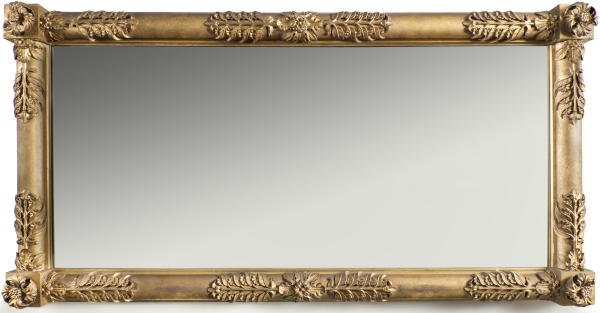
FIG. 6. Looking glass, attributed to John Doggett & Co., Boston, 1820. White pine; h 32¼, w 62¾. Worcester Art Museum; Bequest of Stephen Salisbury III (1907.175), on loan to the Salisbury Mansion. Photo, Gavin Ashworth. In its present location, the looking glass is shown as a chimney glass, mounted above a parlor fireplace. However, in its original context, it could have served as a pier glass and been hung vertically.
A year earlier, in 1819, David Sears hired architect Alexander Parris to design a grand new house in Boston. He furnished it in equal elegance with imported chimneypieces, furnishing fabrics, and porcelain and ordered stylish furniture and looking glasses from Vose and Doggett. A letter to his agent in Paris in December 1819 mentions “Mr Doggett a dealer in glass having an order to execute,” and the next October he informs his London agent that he has drawn “a bill for one thousand and fifty pounds sterling in favor of Messrs John Doggett & Co.”18 The three chimney glasses and one pier glass that remain in Sears’s drawing rooms may be the largest Doggett ever supplied, one measuring an enormous 102 inches high and 56 inches wide.
Several looking glasses of the form ordered by Sears and the Salisburys have been located. All have corner blocks with a carved central motif and a series of flowers and leaves growing in each direction from a rosette of fairly flat leaves that is placed in the center of the top and sides of the curved frame (figs. 7, 8). Did Doggett copy this neoclassical motif from the decoration on an imported looking-glass frame or piece of furniture or from a design in a pattern book? Or did he adapt it from a gilded furniture mount? All are possible sources.
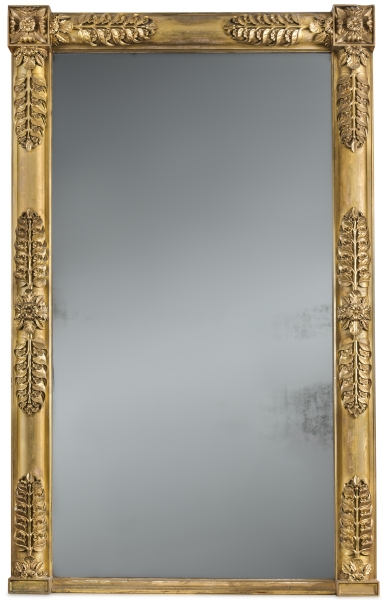
FIG. 7. Looking glass, attributed to John Doggett & Co., Boston, 1820–25. White pine; h 71½, w 43⅝. Colonial Society of Massachusetts; Gift of the grandchildren of Francis Parkman, Jr.: Mrs. John Forbes Perkins, Mrs. Alexander S. Neilson, Mrs. Daniel Sargent, and Mr. John T. Coolidge (5.4.2). Photo, Gavin Ashworth. This pier mirror first belonged to the Rev. Francis Parkman (1788–1853) of Boston. The frame was later altered by the removal of the ornamental blocks and carvings at the base; its original appearance resembled the looking glass in fig. 6.
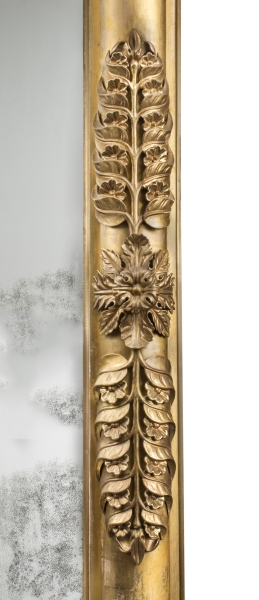
FIG. 8. Carving on the looking glass in fig. 7. Photo, Gavin Ashworth.
A second group of large looking glasses, many with Boston provenances, share similar construction methods and, in some cases, identical turnings (fig. 9). No firm documentation connects this group to Doggett. However, the form and turnings relate closely to a looking glass that descended to Doggett’s great-granddaughter, who also owned the first daybook and the letterbook. It was possibly one of a pair listed in an “Account of Goods purchased for my Daughter” as part of her dowry in 1822.19 It is illustrated in Mabel Swan’s 1929 Antiques article and is visible in a late nineteenth-century photograph of the parlor of the family home in Dedham, Massachusetts.20
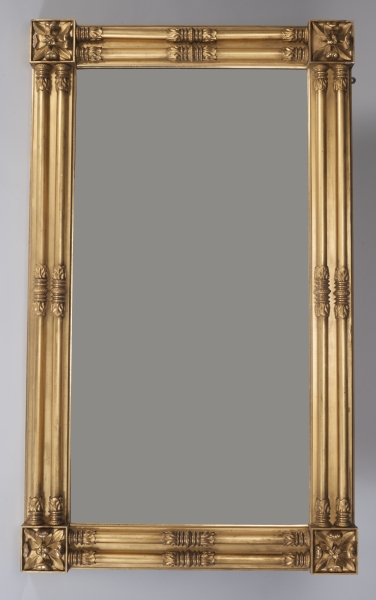
FIG. 9. Looking glass, attributed to John Doggett & Co., Boston, ca. 1818. White pine; h 60⅞, w 36¼. Historic New England; Gift of Catherine Weld Faucon (1918.1180). This pier mirror originally hung in the home of Daniel Weld (1772–1852), 932 Washington Street, Boston.
Other styles of later looking glasses are described in several letters written between 1825 and 1829. One letter to James Maicher (sometimes spelled Marcher) in Halifax, Nova Scotia, reads: “The Glass frames we make of the sizes you mention are a flat side 2½ inches wide with a block at each corner surmounted with a patra cut in wood & gilt—added to the plate is a tablet of 11 inches in height and on it a carved ornament—the pillars or columns of the frame are turned and lay flat on the side and at present the spaces between the turned work we black instead of gilding—wholly, gilt ones can be furnished at the same prices—we make no projection to the top: the whole is round alike—sizes—30.18—28.16—26.15 are all made in this way.”21
A letter to Samuel Rodman Jr. describes a glass with a plate 52 by 25 inches with a “frame 3½ wide with black pillars and corner & centre ornaments” for $80 and others with “a moulding frame 3½ wide, similar to a picture frame moulding . . . a kind of frame we are now making a great many of—plain and neat.”22 Another letter written the same year informs Joshua J. Hall of New Orleans that “the glasses with gilt tablets are of an entire new pattern which we hope will be approved of and the large pair are the richest and best workmanship we are able to produce and are such as we sell here at 400 dollars the pair.”23
Styles for picture and portrait frames also changed during the course of Doggett’s career. In addition to the two labeled frames, others are documented by written records or circumstantial evidence. Among the best documented from Doggett’s early career are those found on the embroidered pictures done at Mrs. Saunders and Miss Beach’s Academy in nearby Dorchester, Massachusetts (fig. 10). The daybooks contain more than thirty entries to Saunders and Beach for such work, as well as charges for several pieces of furniture and a surprising number of casks of beer. Because the name of the school and the student’s name are lettered on the reverse-painted glass mats, the prices and dates for specific embroideries now in private and public collections can be easily traced. In some cases, the name of the student is included in the entry to Saunders and Beach; in others, the girl’s father was charged directly. Frames vary in size from a narrow molding, sometimes embellished with a spiral-twisted turning, to ones with a deep cove like those often seen framing portraits.24
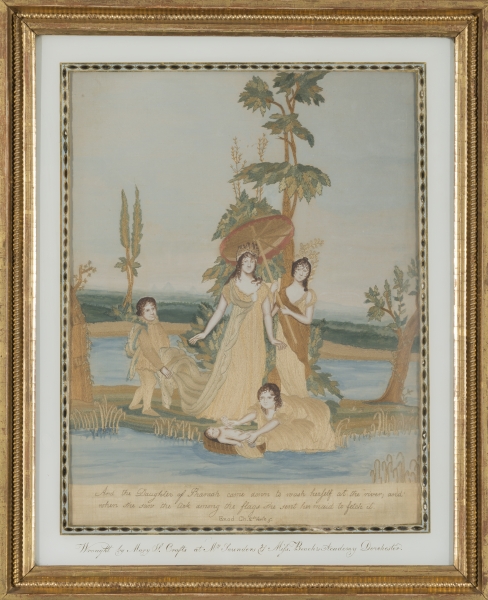
FIG. 10. Needlework picture, “Wrought by Mary S. Crafts at Mrs. Saunders & Miss Beach’s Academy, Dorchester.” Frame attributed to John Doggett, Roxbury, Mass., 1805. White pine; h 21⅞, w 17⅞, d 1½ (including frame). Winterthur Museum; Museum purchase (1959.0066).
Portrait frames provide a different challenge. Although none of those listed in the daybooks have yet been connected to a surviving portrait, the frames on the Penniman portraits of Aaron Willard Jr. and his sister (Willard House and Clock Museum) and Portrait of a Gentleman (Worcester Art Museum) seem likely candidates; they share characteristics with some of the embroidery frames and one of the labeled looking glasses. Doggett’s friendships with the artist and Willard strengthen the connection.
Perhaps the type of frame most often associated with Doggett is one with alternating acanthus and honeysuckle motifs, found on many portraits painted by his friend Gilbert Stuart, including one of Doggett’s mother (fig. 11). Supporting documentation is elusive, suggesting that probably Stuart and not the sitter ordered the frames. Exceptions include the frame of Stuart’s portrait of Governor John Brooks (fig. 12). Brooks’s cousin, Peter Chardon Brooks, noted in his wastebook for April 4, 1817, that he paid Stuart $150 “For a Portrait of His Excellency Gov. Brooks” and “Doggett” $35 for the frame.25 This frame is decorated with a leaf and shield motif identical to those on the frames of Stuart’s 1815 portraits of Francis and Margaret Stackpole Welch (Worcester Art Museum), thus helping substantiate the family tradition that the frames were made by Doggett. The same distinctive molding frames a large looking glass that descended in the Paine family of Boston (Colonial Society of Massachusetts).
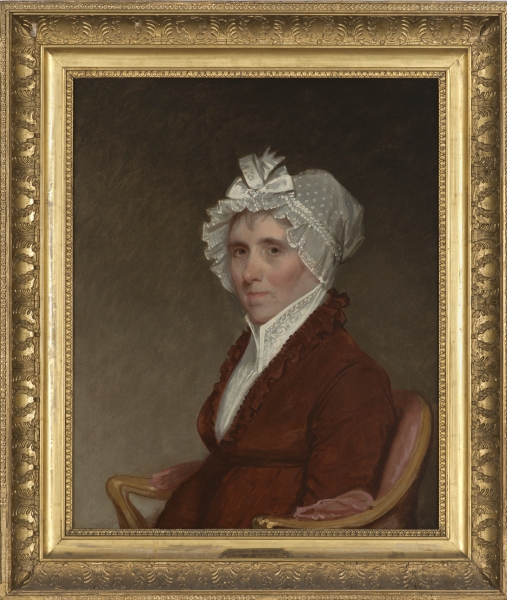
FIG. 11. Elizabeth Badlam Doggett (1753–1832), painted by Gilbert Stuart (1755–1828), frame attributed to John Doggett & Co., Boston, 1815. Oil on canvas; h 36⅝, w 31½ (including frame). Santa Barbara Museum of Art; Gift of Mrs. Charles S. Dennison (1941.7.2). This portrait depicts John Doggett’s mother.
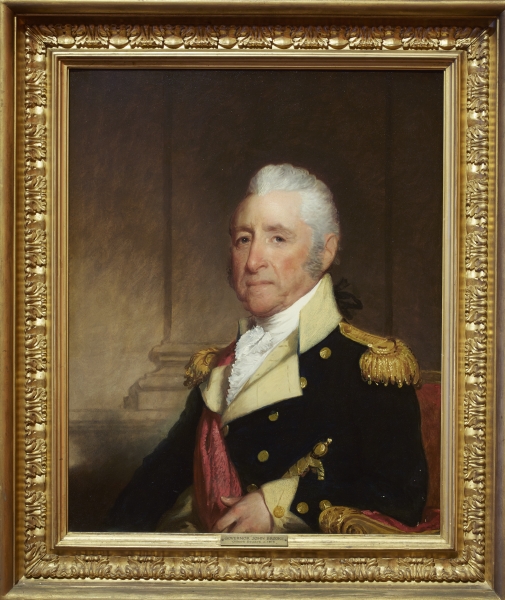
FIG. 12. Governor John Brooks (1752–1825), painted by Gilbert Stuart, frame by John Doggett & Co., Boston, 1817. Oil on wood panel; h 40, w 34 (including frame). Honolulu Museum of Art; Gift of Mrs. Edward T. Harrison, in memory of her husband, Edward T. Harrison, 1965 (3370.1).
The frames pictured on the family portraits illustrated in the 1894 Doggett genealogy also aid with attributions. Those on the 1815 portraits of Doggett’s parents (see fig. 11) lend credence to the suggestion that their son was responsible for the ubiquitous acanthus and honeysuckle frames. The shaped profiles, decorative corner motifs, and foliate and floral scrolls on the frames pictured in the photographs of Rembrandt Peale’s 1828 portrait of Doggett (fig. 13) and that of his brother Samuel by an unknown artist (fig. 14) illustrate two of the more elaborate types that the firm most likely produced somewhat later.26 The shell surrounded by C scrolls and the egg-molded fillet used on the frame (no longer extant) of John Doggett’s portrait are also found on the frames of paintings originally owned by men known to have patronized him. These include The Lady with the Red Hat by Greuze (Museum of Fine Arts, Boston), owned by Thomas Dowse, and Moonlight (fig. 15) and Rosalie (Historic New England) by Washington Allston, owned originally by Henry Pickering and Nathan Appleton, respectively. Examples of the same corner motif and floral and leaf decoration on Samuel Doggett’s frame are found on framed portraits of Martha and Supply Clapp attributed to Edward Savage (Historic New England).
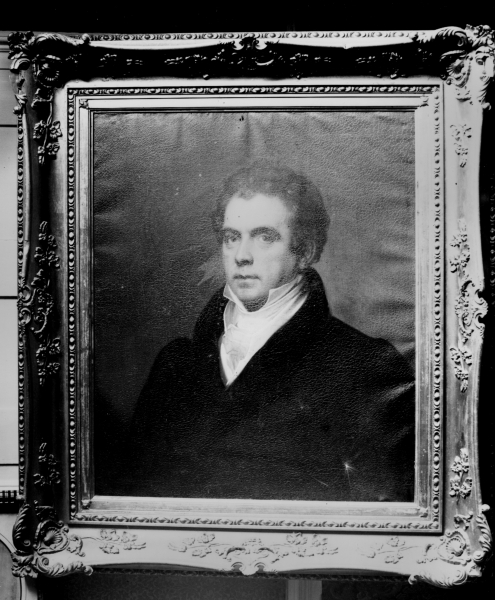
FIG. 13. Photograph of a portrait of John Doggett, Jonathan F. Guild (1871–1940), Dedham, Mass., 1890–94. Glass-plate negative. Dedham Historical Society and Museum. This photograph shows the Peale portrait in fig. 1 with its original frame, which was likely made in Doggett’s shop.
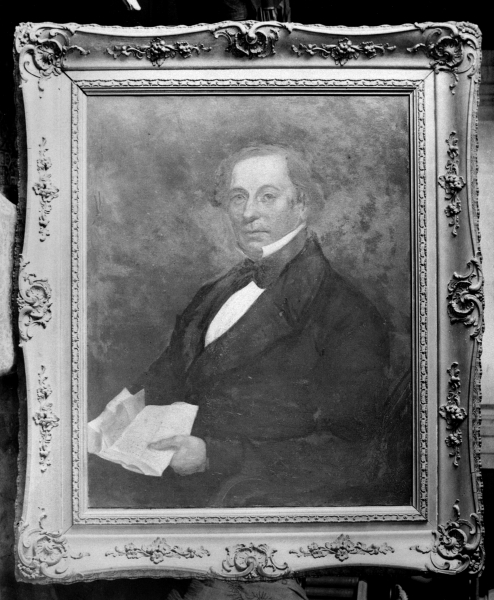
FIG. 14. Photograph of a portrait of Samuel Doggett (1794–1856), Jonathan F. Guild, Dedham, Mass., 1890–94. Glass-plate negative. Dedham Historical Society and Museum. This photograph of John Doggett’s brother is one of seven taken by Guild that record portraits of Doggett family members.
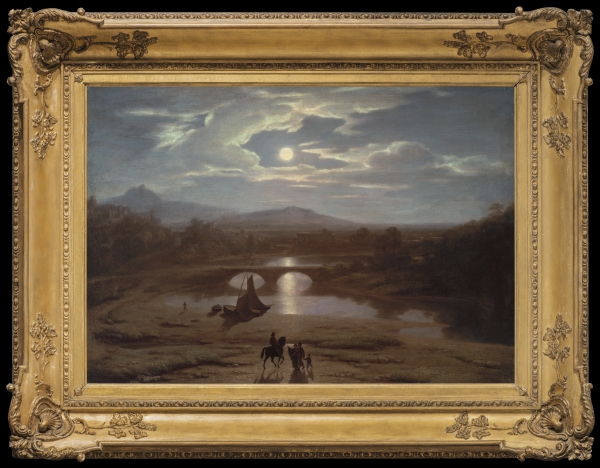
FIG. 15. Moonlight, Washington Allston (1779–1843), frame attributed to John Doggett & Co., Boston, 1819. Oil on canvas; h 36½, w 47¼ (including frame). Museum of Fine Arts, Boston; William Sturgis Bigelow Collection (21.1429).
Other documented Doggett frames in a variety of patterns with different motifs are on the Stuart “Athenaeum” portraits of George and Martha Washington (National Gallery of Art and Museum of Fine Arts, Boston), his portraits of James Perkins and William Shaw (Boston Athenaeum), and Chester Harding’s portraits of Elizabeth Salisbury and her son Stephen of 1829 (Worcester Art Museum). Like the ornaments on his own portrait frame, these can serve as the basis for likely attributions.27 One presumes that individual composition elements could have been combined in any number of ways to create a variety of framing patterns. In an 1827 letter to William Starbuck on Nantucket, Doggett mentions “the number of our patterns which are 2 or 3 hundred.”28
Frames with a deep cove molding and carved shells in the corners make up another group of documented frames. The earliest use of these shells is on Thomas Sully’s Passage of the Delaware, which Doggett owned and exhibited in 1823.29 Most date to the 1830s, however, and include the frame for Henry Sargent’s Landing of the Pilgrims (figs. 16, 17), for which the Pilgrim Society of Plymouth, Massachusetts, paid Doggett $189.64 in 1836.30 The letter to William Starbuck referenced above contains an interesting perspective on how some of Doggett’s clients ordered frames: “Most of the persons who we are framing landscape paintings for . . . have some particular pattern in their houses, which all are made like.” The Boston Athenaeum apparently followed this aesthetic when it hired Doggett to frame many of the portraits it commissioned, as well as some paintings it purchased, for its collection. Chester Harding’s portraits of Daniel Webster, John Marshall, and Hannah Adams, and Thomas Sully’s portrait of Athenaeum benefactor Thomas Handasyd Perkins, have frames with carved shells in the corners. This last was ordered by the artist at a cost of $110 in 1831. Larger shells, like those on Passage of the Delaware, were used on the frames commissioned for Robert Charles Leslie’s portrait of Benjamin West, Thomas Cole’s The Angel Appearing to the Shepherds (Chrysler Museum, Norfolk, Va.; frame no longer extant), and Jean-Baptiste-Claude Chatelain’s copy of Guido Reni’s The Archangel St. Michael (location unknown). Doggett also repaired and regilded several of the frames for other paintings owned by the Athenaeum.31
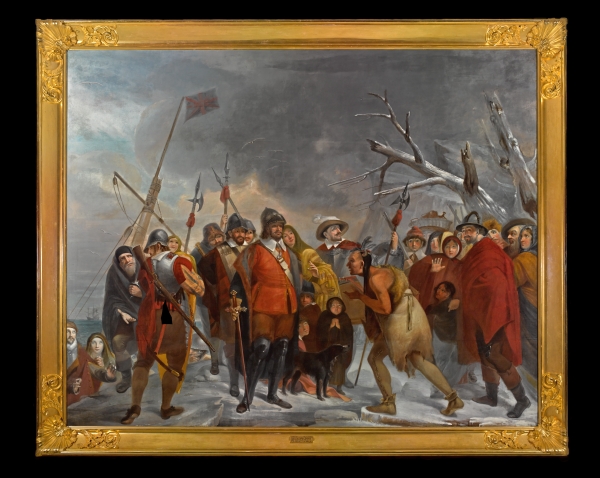
FIG. 16. Landing of the Pilgrim Fathers, Henry Sargent (1770–1845), frame by John Doggett & Co., Boston, painting: 1818–24, frame: 1836. Oil on canvas, white pine frame; h 175, w 211 (including frame). Pilgrim Hall Museum; Gift of the artist, 1834 (0039). Doggett charged $189.64 for this frame.
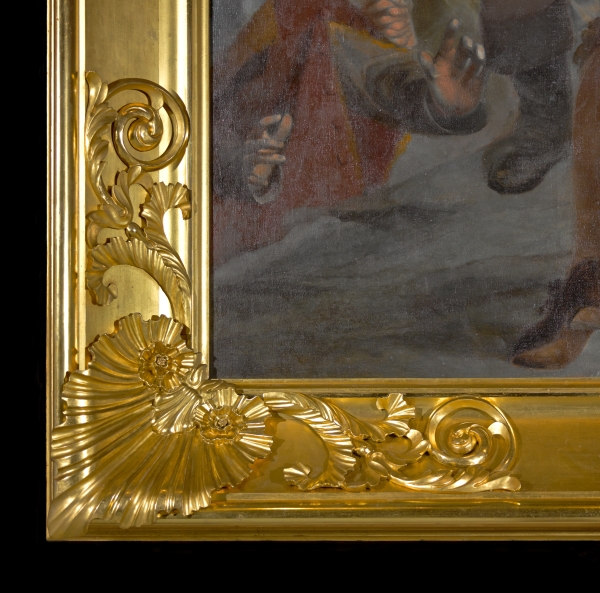
FIG. 17. Corner of the frame in fig. 16.
DOGGETT’S REPOSITORY OF ARTS
A small advertisement in the Columbian Centinel of January 24, 1821, can be viewed as a prelude to Doggett’s next entrepreneurial venture, that of exhibiting art in addition to framing it. It reads: “AMERICAN PAINTINGS. Two Views of the Falls of Niagara, by Mr. A. FISHER may be seen at J. DOGGETT & CO.’S Looking Glass Warehouse for a few days, previous to their going to the Southward.”32 Within a few months, Doggett had taken an additional space at 16 Market Street, and the next year he moved the Looking Glass Warehouse to adjoining spaces below it at numbers 12 and 14, where the company remained until 1837, when it moved to Tremont Row. A notice in the Boston Daily Advertiser for March 19, 1821, describes the new space as “the large and commodious Chambers, No. 16, Market street; near the market, over shops No 12 and 14, lately occupied by James Vila and Co. being the largest Chambers, in the street, and well calculated for the sale of domestic goods, or any articles requiring much room. Rent 200 dollars.”
The first “article” that Doggett put in this space did, indeed, require “much room.” Rembrandt Peale’s painting The Court of Death (fig. 18) measured 11½ feet by 23½ feet and opened there for public view on April 25, 1821. Peale had finished this large canvas the previous July after nine months of work; it was charged with personal references and reflected his views on religion, war, and temperance. Like many things involving the Peales, the painting was a family affair. Peale’s daughters posed for the figures of Faith, Hope, Virtue, and Pleasure; his father for Old Age; his brother as the drunken youth; and his infant daughter as the orphan being trampled by War.
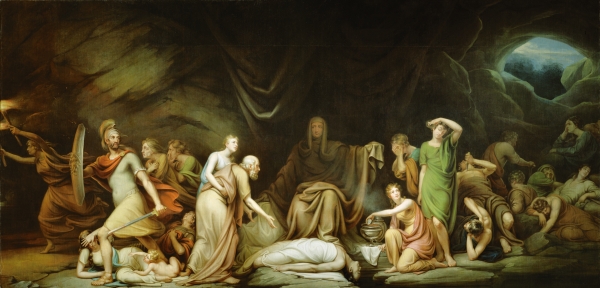
FIG. 18. The Court of Death, Rembrandt Peale (1778–1860), Boston, 1820. Oil on canvas; h 138, w 281. Detroit Institute of Arts; Gift of George H. Scripps (85.3).
The painting toured between 1820 and 1823, traveling to Philadelphia, New York City, Albany, Charleston, and Savannah as well as many places in between. (Doggett showed it again in 1823.) It was enormously successful and, being advertised as the “GREAT MORAL PICTURE,” was the subject for many sermons.33 Admission was 25 cents, and in its first year it earned almost $9,000 and was seen by 32,000 people. Before it traveled to Boston, Peale had sent to John Pendleton, whom he had hired as manager, a list of ministers who should be sent invitations to the exhibition.34 In 1830, the Boston Commercial Gazette reported an amusing story about one minister who declined. “Taken by Surprise.—At the time when Mr. Peal [sic] was exhibiting his beautiful picture of the Court of Death in Boston, he sent the late Rev. Dr. Osgood a ticket, on which was inscribed, ‘Admit the bearer to the Court of Death’; the old gentleman never having heard of the picture, was utterly confounded—‘I expected to go before long,’ said he—‘but I was not prepared for so abrupt a summons.’”35
Today, it is difficult to understand the popularity of the exhibition pictures and panoramas available to Bostonians in the early nineteenth century, along with other amusements held at assembly rooms over the public markets and in several of the recently opened museums, such as the Columbian Museum and Edward Savage’s museum in the Boylston Market. Often they were accompanied by music, and many were illuminated for evening viewings. Between 1815 and 1830, the Columbian Centinel advertised a range of subjects, including conflagrations, views of foreign cities, battles of the War of 1812, and Jacques-Louis David’s Coronation of Napoleon (Louvre Museum) and John Vanderlyn’s Panorama of the Palace and Gardens of Versailles (Metropolitan Museum of Art). The advertisements often stressed the size of the paintings, sometimes by their dimensions but often by the number of square feet they encompassed. A Panorama of Paris, for example, was 18 feet high and 150 feet long, and the battles of the War of 1812 took up one thousand square feet.
By late September, encouraged no doubt by the success of The Court of Death, Doggett had named 16 Market Street as Doggett’s Repository of Arts and advertised it as a “new and elegant establishment . . . fitted up in the first style, and open for public inspection this day. The Proprietors flatter themselves that the visitors will find the Gallery a source of pleasure and gratification, superior to any other of the kind in the United States.”36 Hyperbole was never lost on Doggett.
For the next several years, Doggett’s Repository was host to additional traveling paintings as well as exhibitions and sales of old master paintings and prints that could only increase the connection of his name with art, and therefore the visibility of the framing aspect of the business. Doggett had observed the success of similar endeavors in this part of town and was more than happy to be associated with them. Only occasionally did he succumb to showing curiosities like some of the other local establishments. Among them were the exhibition and sale of “an elegant collection of INSECTS, recently brought from South America,” the exhibition of an Egyptian mummy (fig. 19) that had recently been donated to the Massachusetts General Hospital (and is still on exhibition there!), and a showing of “a very rare plant, the Yucca Glorioso” “as soon as it is in flower.”37
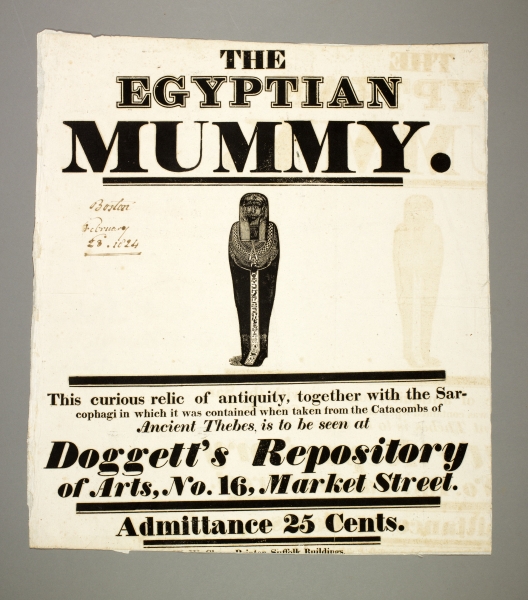
FIG. 19. THE EGYPTIAN MUMMY, Boston, 1824. Broadside; h 21¼, w 18⅞. Boston Athenaeum (Bro. 5.140).
Doggett’s Repository opened with a month-long exhibition of 164 paintings, advertised as “the most valuable collection of CABINET PAINTINGS, that have ever been exhibited in America, the greater part of which have adorned the various Palaces and Cabinets on the continent of Europe.”38 The cover of the Descriptive Catalogue, which could be bought for 12½ cents, stated that these were “selected on the continent of Europe, at the expense of thirty-thousand dollars, and are warranted to be the works of the Great Masters, from the 13th century to the present time.” Admission cost 25 cents, and a note on the bottom of the catalogue “respectfully requested” visitors “not to touch the Pictures, and to leave their canes and umbrellas in the care of the Door-keeper when they enter the Gallery.” Buried in the text was a notice that the entire collection was offered for sale privately.39 Clearly there was no offer as the paintings were sold at an auction two months later .
An exhibition of portraits of the first five U.S. presidents by Gilbert Stuart followed in January 1822. Doggett had commissioned the paintings for $50 apiece; when they were later exhibited at the Boston Athenaeum, the catalogue noted that the portraits “comprise the only uniform series of the Presidents in existence and were painted expressly for the Messrs. Doggett.”40 Doggett did not want the harsh weather at that time of year to reduce visitation, so the newspaper advertisements assured potential viewers that “the Room will be . . . kept warm.”41 Although the exhibition was scheduled to close in March, a letter to the editor of the Boston Daily Advertiser notes that the portraits were still on view in June and states, “Had Mr. Stuart never painted any thing else, these alone would be sufficient to ‘make his fame’ with posterity.”42
The point of the letter, however, was not to praise Stuart’s skill in capturing likenesses but to encourage the public to visit the main exhibition at the art gallery: a collection of fifty-two watercolor copies of old master paintings. The unidentified author praised Doggett for creating “one of the most elegant Establishments for rational amusement in the country” but felt the exhibition “has been neglected,” even though Boston newspapers had published a glowing review and letters of recommendation from both Benjamin West and Sir Thomas Lawrence. The collection had been won in a lottery in England by Thomas Dowse, a Cambridge, Massachusetts, tanner and collector of rare books. What better way to educate eager artists and the public’s growing interest in the fine arts than to have them see a collection that William Dunlap, chronicler of the artistic endeavors of the young republic, called “invaluable for their correctness and beauty, and for the truth with which they represent the style, the composition, the drawing, and the colouring of those masters, whose work we rarely see on this side of the Atlantic.”43
Dunlap exhibited one of his own paintings at Doggett’s Repository in July 1822. As he tells us: “I put up my picture in Doggett’s great room, a noble place, soon afterward appropriated to other purposes; and although I had my vanity gratified, I experienced that very warm weather is unpropitious to exhibitions.” The painting, titled The Christ Rejected, was another large canvas, measuring 12 by 18 feet, and could be seen from 9 a.m. until 9:30 p.m.44 Dunlap had composed it based on a printed description of a picture with the same title painted by Benjamin West. Although unsuccessful in Boston because of the warm weather, the painting made a profit of between $200 and $300 when it was shown later that year in Portland, Maine. On his return to Boston, Dunlap exhibited portraits and some other paintings at Doggett’s; before he left in November, four were sold at auction, including one of John Adams valued at $50 and a copy of Sir Thomas Lawrence’s portrait of the artist Benjamin West valued at $100.45
Two paintings that are today considered icons of American art were dismal failures when shown next at Doggett’s Repository. The first was Samuel F. B. Morse’s House of Representatives (Corcoran Collection, National Gallery of Art), which arrived from a New Haven showing by sleigh for an opening on March 1, 1823. Decorative arts historians now study the painting for what it reveals about period lighting (from the great Argand chandelier), as well as drapery and carpet patterns, but in its own time it was hailed primarily for its architectural correctness, providing a glimpse into one of the grandest rooms in the country and enhanced with over eighty individual portraits. Inhabitants of Boston in 1823, however, were not as interested in the painting as Morse, his agent Henry Cheever Pratt, and Doggett had hoped, and the exhibition was losing money before the end of its seven-week run. It was equally unsuccessful at its next stops—Salem, Massachusetts; Albany, New York; and Hartford and Middletown, Connecticut—and was subsequently rolled up for many years before being bought by a collector in England.46
The other unsuccessful exhibition painting was Thomas Sully’s Passage of the Delaware (Museum of Fine Arts, Boston). William Dunlap called it “an unfortunate picture” and remarked that if one mentioned it to Sully, his response was “I wish it were burnt.”47 It had been commissioned in 1819 by the state of North Carolina but later rejected because of its large size. Doggett thought that, as a historical picture, it had great possibilities of making money and so bought it for $500. He made the frame described earlier and exhibited it at his repository from April to June 1823. In July, he announced that he was going to sell it at auction, complete with its frame and packing case. Instead of calling it an “interesting” painting, as he had when it was on exhibition, he now advertised it as “Sully’s celebrated Painting . . . one of the best of the National Pictures that have been painted recording one of the most important events of the American Revolution, and it is well calculated to adorn a Public Hall, or for an Exhibition.”48 Ethan Allen Greenwood purchased the painting for $510 and immediately sent it to Portland, Maine, to be exhibited before he installed it in his Gallery of Fine Arts the next month.49
Sully was more successful the following November, two months after the return visit of The Court of Death had closed. The next painting he exhibited was a copy of François Marius Granet’s immensely popular painting of the Capuchin Chapel in Rome. Granet had made ten copies, one of which was owned by the wealthy Benjamin Wiggin of Boston. Encouraged by Washington Allston, who thought it would be a profitable exhibition picture, Sully obtained Wiggin’s permission to make a copy, aided, we are told by Dunlap, by Mrs. Wiggin, who did not like her “carpets trodden by the unhallowed feet” of the large number of visitors who wanted to see the original.50
AUCTION SALES
When not used for traveling exhibition pictures, the rooms at Doggett’s Repository were host to a series of auction sales. Between 1821 and 1824, the auctioneering firms of Blake and Cunningham and of Whitwell and Bond held at least six auctions of paintings—primarily of old masters—in the space. The other advertised sales consisted of items—English, French, and Italian engravings—calculated to produce activity for Doggett’s framing business. The advertisement for October 15, 1823, is typical of the types of subjects sold at these sales: “A collection of English, French and Italian Engravings; among which are many rare and beautiful Prints, consisting of valuable Scripture Pieces, Sacred Subjects from the old Masters—Landscapes—Portraits—fancy pieces—colored pieces—Drawing pieces—Heads-Caricatures—Costumes of the different people of Europe—Paris Fashions, &c.”51
The painting sales at Doggett’s gallery were well advertised, and many were accompanied by printed catalogues. Newspaper notices were addressed to “lovers of the fine arts” or “worthy of the attention of the amateur” and list a variety of consignors. One announced the sale of “property of an eminent native artist who contemplates leaving the country.” Another was for a “collection made by a gentleman of distinguished taste for his own gratification solely . . . equal if not superior to any which are to be found in the country.” (He, too, was going to leave the country.) Others were “said to be a valuable collection,” “recently imported from London,” or “selected in Italy with great care by a gentleman from Boston.”52
The auction held on November 22, 1821, was of the paintings that had been exhibited since September; the date and conditions of the sale were printed on a sheet pasted over the text on the cover of the Descriptive Catalogue for the previous exhibition. The catalogue’s text is a combination of artists’ biographies, connoisseurship, and sales pitches similar to those found in such publications today. The range of subjects recalls those in the advertisement for the print sale described above. Paintings by only two contemporary American artists were included—The Capture of Major Andre (Worcester Art Museum) by Thomas Sully and nine by the recently deceased John Lewis Krimmel, including his well-known Quilting Party (Winterthur Museum). At least two of the Krimmels were bought by Nathaniel Devaltooth, an English-born merchant, framemaker, and collector residing in Boston. Devaltooth had bought more of Krimmel’s pictures than anyone else at the sale of the artist’s effects in Philadelphia three months earlier.53
Textile merchant Nathan Appleton was one of the many members of Boston’s elite who purchased paintings at this sale. Like David Sears, Appleton had built a house designed by Alexander Parris and outfitted it with furniture by Vose and elegant imported goods. Surviving examples of these furnishings, along with late nineteenth-century photographs of the interior (see the essay by Mussey and Pearce in this volume), provide one of the best records of high-style taste in Boston at the time. Completing the picture are several of Appleton’s paintings, their invoices, and his copies of the catalogues for three sales he attended.
The earliest catalogue is for the first major sale of the 1820s.54 It took place at the Gallery of Fine Arts, which had been established in 1818 and was located over the new city market on Brattle Street, one street away from Doggett’s Looking Glass Warehouse. Originally scheduled for December 28, it was postponed for a week to allow time to repair a joist on the second floor that had given way from the weight of the more than five hundred attendees of the sale.55 Appleton and another individual, Samuel B. Walcott, annotated their catalogues with the names of the purchasers of many paintings and the amount they paid for each. The names are a who’s who of Boston society at the time and include successful merchants and two prominent ministers. Appleton bought two landscapes, a seascape, and a painting of The Virgin and Child for a total of $292 (fig. 20).56
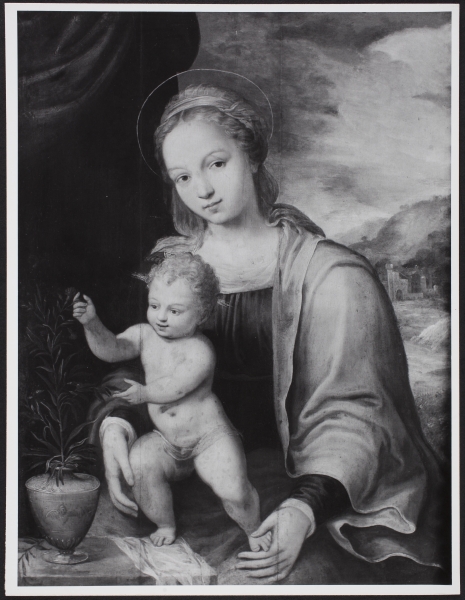
FIG. 20. Photograph of the painting The Virgin and Child, painting: 18th-century copy listed in auction catalogue as “Painted by Raphael”; photo: Boston, 1979. Historic New England; Weld-Appleton Family Papers, Miscellaneous Manuscripts, Box 1. Nathan Appleton (1779–1861) of Boston purchased the painting at auction in January 1821.
In Appleton’s catalogue for the November 22, 1821, sale at Doggett’s Repository (fig. 21), an X mark to the right of the entries for five pictures corresponds to the numbers on two invoices, one from the auctioneers Blake and Cunningham and the other from the aforementioned Nathaniel Devaltooth, consignor of the picture.57 Number 40 was titled Upright Landscape, with Italian Ruins, Figures reposing, Sportsmen, &c by “Zucarillo” (fig. 22). Appleton paid $50 for it and later wrote “N. Appleton No 1” in ink on the back of the frame. The invoice from Devaltooth records that he paid $90 for A beautiful young Lady, perusing a Letter by Candle-light, listed in the catalogue as by Mieris but in fact a painting after Jean Raoux (fig. 23).
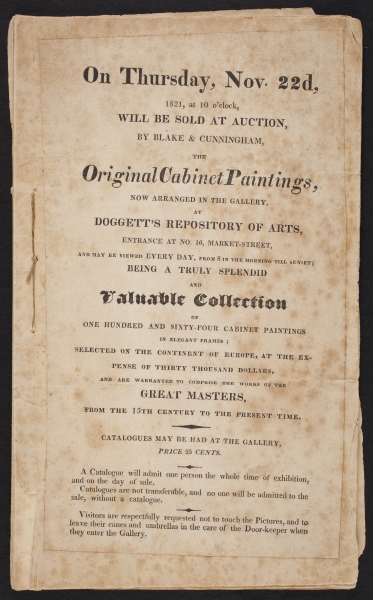
FIG. 21. Catalogue, Sale of Original Cabinet Paintings at Doggett’s Repository of Arts, Boston, 1821. Historic New England; Weld-Appleton Papers, Miscellaneous Manuscripts, Box 1. This copy of the catalogue belonged to Nathan Appleton of Boston.
FIG. 22. Italian Landscape, attributed to “Zucarillo,” probably Francesco Zuccarelli (1702–1788), Italy, 1750–80. Oil on canvas; h 49½, w 41⅞ (including frame). Historic New England; Estate of William Sumner Appleton (1966.1814). Nathan Appleton purchased this picture at auction at Doggett’s Repository in 1821.
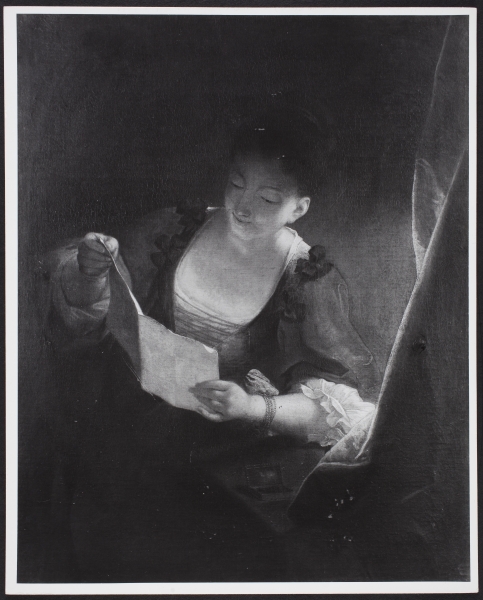
FIG. 23. Photograph of the painting A beautiful young Lady, perusing a Letter by Candle-light, painting: late 18th-century copy after Young Lady Reading a Letter, Jean Raoux (1677–1734), Paris, before 1734. Photograph, 1979. Historic New England; Weld-Appleton Family Papers, Miscellaneous Manuscripts, Box 1. Nathan Appleton purchased this painting at auction at Doggett’s Repository in 1821.
On October 9, 1823, Appleton wrote “Pickering’s Pictures” on the cover of the third catalogue, identifying the owner of “A very choice and superb collection of PICTURES, by the old masters, all in the most costly and elegant frames.”58 (We can only wonder if those frames had been purchased by Pickering from Doggett.) Appleton bought eight of the thirty-four paintings in the sale and, again, an X to the right of the catalogue entry corresponds to the surviving invoice from auctioneers Whitwell and Bond. His purchases included Scene in Italy by Thomas Doughty and the Interior of a Dutch Church, now identified as Interior of St. Bavo Church, Haarlem (fig. 24).
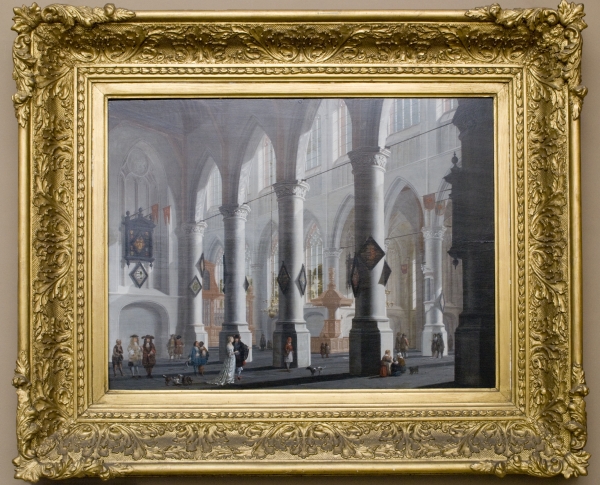
FIG. 24. Interior of St. Bavo Church, Haarlem, Daniël de Blieck (ca. 1610–1673), Holland, 1664. Oil on canvas; h 32⅜, w 39 (including frame). National Park Service, Longfellow House-Washington’s Headquarters National Historic Site (LONG 4966). Nathan Appleton purchased this painting at auction at Doggett’s Repository in 1823.
When Appleton died in 1861, Interior of a Dutch Church, Beautiful Young Lady, and ten other paintings hung on the walls of his drawing room. When the room was photographed in the 1880s, many others were still there, including The Virgin and Child from the 1821 sale, which can be seen to the right of the large chimney glass similar to those Doggett had supplied to Appleton’s neighbor, David Sears (fig. 25). Appleton continued to patronize Doggett and ordered a large looking glass as part of the furnishings he purchased in 1843 for his daughter and her husband, Henry Wadsworth Longfellow.59
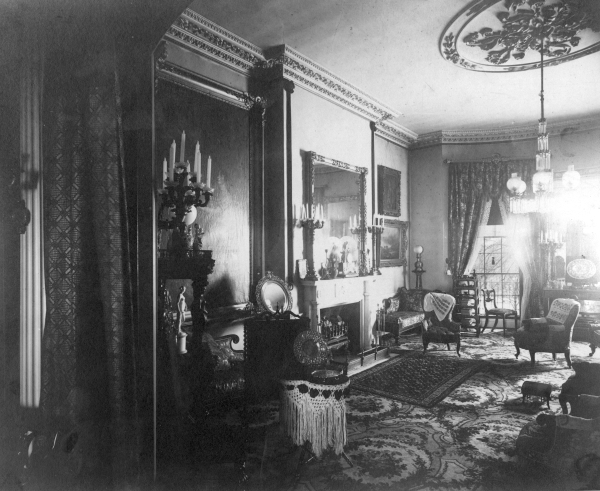
FIG. 25. The drawing room of Nathan Appleton’s house, Boston. Photograph, ca. 1886. Historic New England. The painting of The Virgin and Child purchased by Nathan Appleton in 1821 (see fig. 20) hangs to the right of the fireplace, above a landscape. For another view of this room, see fig. 14.
Charles Russell Codman, another Beacon Hill resident, provides an additional perspective on Doggett and the fine arts in Boston. He, too, frequented the auctions of old master paintings and purchased over thirty works, more than doubling the size of the collection he had inherited from his father. Codman was considered a true connoisseur and his collection was the best in Boston at the time; New York collector Philip Hone called it “a splendid Gallery of ancient paintings, many of which are originals of great artists.”60
Codman’s account book reveals that, like Nathan Appleton and David Sears, he followed the pattern of patronizing Alexander Parris, Isaac Vose, and John Doggett. Between 1817 and 1832, he made payments of $1,124.26 to Doggett.61 Many occur several months after he records the purchase of paintings, suggesting that Doggett supplied frames for unframed paintings or perhaps replaced existing frames in a more suitable style. Surprisingly, none of the payments to Doggett was for a looking glass, and, unfortunately, Codman’s grandson reframed most of the paintings that he inherited.62
In 1827, Codman was one of five members of a committee charged to gather paintings for display in an exhibition “for the encouragement of the Fine Arts” at the new gallery of the Boston Athenaeum. After only four days, 1,300 ticket holders had viewed the collection of 317 paintings on loan for the show; many of these works had been purchased at the Gallery of Fine Arts sale in 1820. The exhibition was so successful that another was held the next year, and Codman lent ten of his pictures. Doggett lent the portraits of himself and his wife, Sophia, by Rembrandt Peale as well as Washington Allston’s Moonlight Landscape, which had just been given to him to sell by Henry Pickering of Salem. The added attraction for the 1828 exhibition were thirty-eight paintings from the collection of Thomas Jefferson, which had been sent to Boston for sale there.63
THE LOOKING GLASS AND CARPET WAREHOUSE
The last painting exhibited at Doggett’s Repository was Jacques-Louis David’s Cain and Abel. Traveling exhibitions and painting auctions continued to be part of Boston’s cultural scene, but Doggett was no longer an active participant. Instead, he diversified his business in 1825 to include another commodity for the embellishment of Boston’s interiors as well as for profit. On March 9, he published a notice that Doggett & Co. had purchased the stock of carpets and table linens, together with all the spring orders arriving from mills in England and Scotland, from Joseph Bacon, who four years earlier had set up a carpet business in the stores adjacent to the Looking Glass Warehouse. In April, the company placed another ad, which continued for the next several months, informing the public that it had removed the carpet stock “to the spacious Hall over their Looking Glass Establishment recently occupied as a Repository of Arts.”64 The company’s billhead was changed to “Looking Glass and Carpet Warehouse.” Bacon was kept on for a while; he traveled to England and Scotland to introduce Samuel Doggett to the mills and agents there and to select new carpet patterns.
The letterbook provides a fascinating window into the carpet business in Boston during the years 1825 to 1829, providing the names of the English mills that supplied Venetian, Brussels, Wilton, and Imperial carpets and describing the colors and pattern types that Doggett’s customers preferred. It also documents the effects of tariffs on imported carpets and Doggett’s subsequent dealings with the beginnings of the American carpet industry. In 1827, he advertised “AMERICAN CARPETING . . . which in point of quality and durability of colours, equals the best imported.”65 This product came from a newly established mill in Somersworth, New Hampshire; Doggett later dealt with the mills in Lowell, Massachusetts, and one in New Jersey. His newspaper advertisements at this time emphasize the carpeting arm of the business but always note in smaller type at the bottom that looking glasses and glass plates were available “as usual.” By 1830, the business was so successful that a copartnership with Jacob Farnsworth in Philadelphia was formed and a branch called Doggett, Farnsworth & Co. opened at 134 Chestnut Street in Philadelphia, selling both carpeting and looking glasses. When Louis McLane, secretary of the treasury, published a survey of manufactures in the United States three years later, he lists a “Looking Glass Frame and Rug Factory” in Roxbury, presumably Doggett’s, that employed eleven men at a wage of $1.50 a day and produced $8,000 in frames and $35,000 in rugs a year.66
In addition to documenting the carpet business, the letterbook provides much information on the huge numbers of both silvered and unsilvered glass plates for looking glasses and plate glass for windows that the company continued to import from England, Germany, and France. Not all arrived in perfect condition; many plates were broken and others were stained from the paper placed between them in the crates. One letter to the Royal Plate Glass Manufactory in France in 1827 requests that the twenty-eight plates in the order, ranging in size from 75 by 43 inches to 52 by 37 inches, be “well packed with flannell between them”; the letter also requests “double the quantity of Tin foil that will be necessary to silver the above.”67
THE AMERICAN KINGS
The letterbook only hints at another endeavor in which Doggett became involved, the production of prints through the new process of lithography. Soon after Gilbert Stuart painted the series of the American presidents for Doggett in 1822, the two men embarked on a project to engrave the paintings as prints offered for sale to the public. Washington Allston wrote to the artist Charles Robert Leslie in London for advice on the process, what the cost would be for the size of paper Doggett had specified, if he thought the prints might also sell in England, and, indeed, if the paintings “would be likely to produce any profit if exhibited there.”68
The paintings were never engraved in England. The project came to fruition only through the efforts of John Pendleton, whom Doggett had first met when he was managing the tour of The Court of Death for Rembrandt Peale and whom, by 1825, he had hired as a purchasing agent for looking-glass plates in France. While there, Pendleton visited some of the new lithography establishments with artist Alvan Fisher, with whom he was traveling. On November 16, 1825, the Columbian Centinel announced “Portraits of the Presidents. MESSRS. DOGGETTS of this city, have received from France, Lithographic Plates of the fine Portraits of the five Presidents of the United States, from the pencil of STUART; and which adorned the residence of the Nations Guest [Lafayette] during his visit to the city. We learn, that the plates are most excellent samples of the skill of the first of the French Artists; and that with the plates, Messrs. D. have received a press to strike off the impressions, and a French pressman to conduct the work.” The set was known as the American Kings (fig. 26) and is discussed in many books and articles on lithography.69
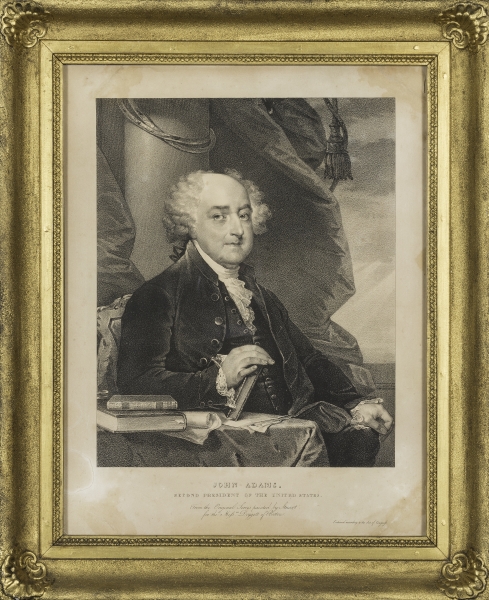
FIG. 26. JOHN ADAMS, SECOND PRESIDENT OF THE UNITED STATES, drawn on stone by Nicholas-Eustache Maurin (1799–1850), after Gilbert Stuart, Paris, ca. 1828, printed by Pendleton Lithography for John Doggett & Co., frame attributed to John Doggett & Co., Boston, 1828. Lithograph, white pine frame; h 19, w 15½. Private collection. Photo, Winterthur Museum.
The prints were enormously successful, and although Doggett did not invest further in lithography, the business set up by John Pendleton and his brother William flourished. It became a training ground for many individuals, including Nathaniel Currier, who went on to establish their own businesses and create the enormous print culture of the nineteenth century—a framemaker’s dream.
John Doggett retired in 1850 and returned to the family home in Dedham. No doubt he could look back with satisfaction on his career, for the role he and his firm had played in expanding the artistic taste of Boston as well as for embellishing the interiors of both private houses and public buildings in the most up-to-date style. Williams and Everett continued the business as Doggett and Co.’s successor and maintained its tradition of providing Boston consumers with the best in paintings, prints, and frames for another sixty years until closing in 1907.
* * *
I would like to thank Brock Jobe and Gerry Ward, the Four Centuries of Massachusetts Furniture Project, and John Tyler and the Colonial Society of Massachusetts for the opportunity to publish this research on John Doggett, which I began in the mid-1970s and some of which I presented at the “Boston Furniture Symposium” at the Peabody Essex Museum, November 14–16, 2003. I would also like to thank Jane Nylander, who transcribed many of the newspaper advertisements from original copies of the Columbian Centinel, and Robert Mussey, who generously shared the many references to Doggett that he has found in his ongoing research on Boston cabinetmakers.

1. Columbian Centinel, “G. G. Channing Furniture Auction,” June 30, 1824; and Boston Commercial Gazette, “Country Seat by Auction,” June 18, 1832. The Vose cabinetmaking firm also was singled out in similar auction notices.
2. First Exhibition and Fair of the Massachusetts Charitable Mechanic Association (Boston: Dutton and Wentworth, for the association, 1837), 24. “Fisher” is the artist Alvan Fisher; frames on many of his paintings are attributed to Doggett.
3. Letterbook of John Doggett & Co., p. 219, coll. 330, 64x11, Downs Collection, Winterthur Library (hereafter DC, WL).
4. William Maurer, unpublished manuscript; a copy is in the author’s collection.
5. Samuel Bradlee Doggett, A History of the Doggett-Daggett Family (Boston: Rockwell and Churchill, 1894), 437.
6. John Doggett daybook, coll. 330, 64x10, DC, WL. The daybook descended in Doggett’s family with the letterbook cited in n. 3; both were owned by his great-granddaughter, Isabel Cobb French, in Dedham, Mass., when the daybook was first published in Mabel Munson Swan, “The Man Who Made Simon Willard’s Clock Cases,” Antiques 15, no. 3 (Mar. 1929): 196–200. The second daybook is privately owned and on loan to the Willard House and Clock Museum, Grafton, Mass.
7. Columbian Centinel, June 18, 1803.
8. Independent Chronicle, Feb. 6, 1806.
9. See David L. Barquist, American Tables and Looking Glasses in the Mabel Brady Garvan and Other Collections at Yale University (New Haven: Yale University Press, 1992), for a discussion of the looking-glass trade in general and specifics on Doggett’s relationships with Cermenati (326–27), Stillman Lothrop (332), and Elizabeth Derby (320–21). Objects owned by Elizabeth Derby are in the collections of the Museum of Fine Arts, Boston, and the Peabody Essex Museum in Salem, Mass.
10. The drawing of the building is in the collection of Historic New England (hereafter HNE) and illustrated in James O’Gorman, ed., Drawing toward Home: Domestic Architecture from Historic New England (Boston: Historic New England, 2010), 20. The family register is privately owned and illustrated in Nina Fletcher Little, Country Arts in Early American Homes (New York: E. P. Dutton, 1975), 74.
11. Albert Sack, The New Fine Points of Furniture (New York: Crown, 1993), 233.
12. For more on Penniman, see Carol Damon Andrews, “John Ritto Penniman (1782–1841): An Ingenious New England Artist,” Antiques 120, no. 1 (July 1981): 147–70; and Robert Mussey and Christopher Shelton, “John Penniman and the Ornamental Painting Tradition in Boston,” in American Furniture 2010, ed. Luke Beckerdite (Milwaukee, Wis.: Chipstone Foundation, 2010), 2–27. For Harris, see Mantle Fielding’s Dictionary of American Painters, Sculptors and Engravers (New York: James F. Carr, 1965), 158.
13. The pair of looking glasses with the Penniman tablets is privately owned and illustrated in Israel Sack, Inc., Opportunities in American Antiques, no. 49 (Oct. 1, 1992). Two others with the simpler label are privately owned; another is illustrated in an undated flyer of Nathan Liverant and Son Antiques. The more elaborate label is on looking glasses in the collections of the Metropolitan Museum of Art, the St. Louis Art Museum, and a pair in the Dallas Museum of Art (Bybee Collection). One is illustrated in American Antiques from the Israel Sack Collection, 10 vols. (Washington, D.C.: Highland House, 1969–92), 3:847. Two others are illustrated in Antiques 32, no. 4 (Oct. 1937): 208; and Antiques 141, no. 5 (May 1992): 843. Two more are recorded in the Decorative Arts Photographic Collection, Winterthur Library, one owned by Mrs. George B. Daniel in 1966, and an oval one owned by Israel Sack, Inc., in 1955.
14. For a complete account of the Boston directory listings for Doggett and John Doggett & Co., see Betty Ring, “Check List of Looking-glass and Frame Makers and Merchants Known for Their Labels,” Antiques 19, no. 5 (May 1981): 1183.
15. Columbian Centinel, Nov. 18, 1818; and Boston Intelligencer, Dec. 12, 1818.
16. Columbian Centinel, Mar. 1, 1820.
17. Abigail Salisbury to Elizabeth Salisbury, July 20, 1820, box 19, folder 5, Salisbury Family Papers, American Antiquarian Society, Worcester, Mass. The Salisbury Mansion is owned by the Worcester Historical Museum. The looking glass is on loan from the Worcester Art Museum.
18. David Sears letterbook, 1817–50, box 6, Sears Family Papers, Massachusetts Historical Society, Boston (hereafter MHS). The Sears Mansion is privately owned.
19. May 1822, opp. 25, Doggett daybook, private collection. These include a chimney glass that descended in the Lyman family of Waltham; a pair of looking glasses from the Gray-Tudor House, the Larches, in Cambridge; and a looking glass originally belonging to Daniel Weld (fig. 9). All are in the collections of HNE. Weld and his brother-in-law John Davis Williams built houses next to each other in Boston about 1818. An invoice from John Doggett & Co. to Williams lists two pairs of looking glasses (87x78, DC, WL).
20. Swan, “The Man Who Made Simon Willard’s Clock Cases,” 198. The photograph is in the collection of the Dedham Historical Society and Museum. The whereabouts of the looking glass are unknown.
21. Doggett letterbook, Dec. 11, 1826, p. 56, DC, WL.
22. Doggett letterbook, May 23, 1828, p. 153, DC, WL.
23. Doggett letterbook July 24, 1828, p. 163, DC, WL.
24. For illustrations of embroideries with Doggett frames done at this school, see Betty Ring, “Mrs. Saunders and Miss Beach’s Academy, Dorchester,” Antiques 110, no. 2 (Aug. 1976): 570–75. For an example of the cove frame, see Wendy A. Cooper, Classical Taste in America, 1800–1840 (New York: Abbeville Press for the Baltimore Museum of Art, 1993), 257.
25. Peter Chardon Brooks, financial wastebooks (MsN2049 Tall), MHS. David Greenough and Charles Russell Codman also paid Doggett directly for the frames for Stuart portraits.
26. Glass-plate negatives taken by Jonathan Guild before 1894 of seven Doggett family portraits in their frames have recently been identified in the collection of the Dedham Historical Society and Museum.
27. Many of the frames on paintings by Alvan Fisher are a case in point.
28. Doggett letterbook, Sept. 14, 1827, p. 102, DC, WL.
29. The shells now on the frame, which had been in storage for nearly a century, are replicas of the originals based on a 1903 photograph.
30. Museum Records, Box 1, May 28, 1836, Pilgrim Hall Archives, Plymouth, Mass.
31. For images of some of these frames, see Cooper, Classical Taste in America, 248; and Stanley Ellis Cushing and David B. Dearinger, Acquired Tastes: 200 Years of Collecting for the Boston Athenaeum (Boston: Boston Athenaeum, 2006), 32, 47, and 51. I would like to thank Hina Hirayama for providing references to Doggett in the Athenaeum archives.
32. Fisher painted Niagara Falls many times. Two views are in the collection of the Smithsonian American Art Museum.
33. Columbian Centinel, Apr. 21, 1821. For more on the Court of Death and some of the other exhibition pictures discussed here, see Harold E. Dickson, “Artists as Showmen,” American Art Journal 5, no. 1 (May 1973): 4–17.
34. Lillian B. Miller, In Pursuit of Fame: Rembrandt Peale, 1778–1860 (Washington, D.C.: National Portrait Gallery, Smithsonian Institution, 1991), 137.
35. Boston Commercial Gazette, Oct. 21, 1830. Rev. Dr. Osgood is probably David Osgood (1747–1822), third minister of the First Parish Church, Medford, Mass.
36. Repertory, Sept. 20, 1821.
37. Columbian Centinel, Jan. 10, 1824, and May 21, 1823; Repertory, Aug. 1, 1822.
38. Repertory, Sept. 20, 1821.
39. Descriptive Catalogue of Original Cabinet Paintings, Library, Brooklyn Museum (ND78 D67).
40. Catalogue for the memorial exhibition of Gilbert Stuart portraits at the Boston Athenaeum in 1828, as quoted in Mabel Munson Swan, The Athenaeum Gallery, 1827–1873: The Boston Athenaeum as an Early Patron of Art (Boston: Boston Athenaeum, 1940), 69. From this set, only the portraits of James Madison (Mead Art Museum, Amherst College, Amherst, Mass.) and James Monroe (Metropolitan Museum of Art) survive; the others were destroyed in a fire in Washington, D. C., in 1851.
41. Columbian Centinel, Jan. 19, 1822.
42. Boston Daily Advertiser, June 20, 1822.
43. William Dunlap, History of the Rise and Progress of the Arts of Design in the United States, 3 vols. (1834; reprint, New York: Dover, 1969), 2:263. For more on the Dowse Collection, see Harry L. Katz, “The Dowse Collection: Old Masters in Watercolors,” in Jonathan Harding, The Boston Athenaeum Collection: Pre-twentieth Century American and European Painting and Sculpture (Boston: Boston Athenaeum, 1984), 95–102. See also Hina Hirayama, “With Éclat”: The Boston Athenaeum and the Origin of the Museum of Fine Arts, Boston (Boston: Boston Athenaeum, 2013), 68–69.
44. Dunlap, Arts of Design, 1:290. An oil sketch of the painting is in the Princeton University Art Museum (1968–120). A printed “Key to the Christ Rejected” is in 57x18.58, DC, WL.
45. Boston Commercial Gazette, Nov. 19, 1822.
46. See William Kloss, Samuel F. B. Morse (New York: Harry N. Abrams, 1988), 69–79, for more on the painting.
47. Dunlap, Arts of Design, 2:134.
48. Columbian Centinel, July 12, 1823.
49. Georgia Brady Barnhill, “‘Extracts from the Journals of Ethan A. Greenwood’: Portrait Painter and Museum Proprietor,” Proceedings of the American Antiquarian Society 103, pt. 1 (1993): 160–61.
50. Dunlap, Arts of Design, 2:134.
51. Columbian Centinel, Oct. 15, 1823.
52. The representative quotations in this paragraph are drawn from six Boston newspapers of the period.
53. Anneliese Harding, John Lewis Krimmel (Winterthur, Del.: The Henry Francis du Pont Winterthur Museum, 1994), 227–29.
54. Box 13, Appleton Family Papers 1539–1941, MHS.
55. Repertory, Dec. 30, 1820.
56. Walcott’s copy of the catalogue is at the Boston Athenaeum (UP .ZB581).
57. Miscellaneous Manuscripts Collection, Box 1, Appleton Family Papers, HNE.
58. Miscellaneous Manuscripts Collection, Box 1, Appleton Family Papers, HNE. Columbian Centinel, Oct. 4, 1823.
59. Sept. 28, 1843, Box 1, Folder 14, Appleton Family Papers, Longfellow House—Washington’s Headquarters National Historic Site, Cambridge, Mass.
60. Diary of Philip Hone, Sept. 15, 1828, as quoted in Ella M. Foshay, Mr. Luman Reed’s Picture Gallery: A Pioneer Collection of American Art (New York: Harry N. Abrams, 1990), 55.
61. Box 3, John Codman IX Family Papers, HNE.
62. The paintings are located at HNE’s Codman House in Lincoln, Mass. For more on Charles Russell Codman’s paintings and his house, see Cora Codman Wolcott, A History of the Codman Collections of Pictures (Brookline, Mass: privately printed, 1935), 68–100; Richard C. Nylander, “A Family Collection,” Historic New England 9, no. 2 (Fall 2008): 2–7; and Richard C. Nylander, “‘In the best style,’” Historic New England 9, no. 1 (Summer 2008): 2–3.
63. Swan, The Athenaeum Gallery, 85–89.
64. Columbian Centinel, Mar. 9, 1825; Columbian Centinel, May 26, 1821; and Independent Chronicle and Boston Patriot, July 9, 1825. No doubt this was the other purpose to which Dunlap alluded in Arts of Design.
65. Boston Commercial Gazette, Nov. 26, 1827.
66. [Louis McLane], Documents Relative to the Manufactures in the United States (1833; reprint, New York: Augustus Kelly, 1969), 292–93.
67. Doggett letterbook, Oct. 6, 1827, p. 103, DC, WL.
68. Quoted in Carrie Rebora Barratt and Ellen G. Miles, Gilbert Stuart (New York: Metropolitan Museum of Art, 2004), 314.
69. For more on the series and Pendleton’s involvement with lithography, see Mabel Munson Swan, “The ‘American Kings,’” Antiques 19, no. 4 (Apr. 1931): 278–81; Sally Pierce and Catharina Slautterback, Boston Lithography, 1825–1880 (Boston: Boston Athenaeum, 1991), 4–6; and Georgia Barnhill, ed., With a French Accent: American Lithography to 1860 (Worcester: American Antiquarian Society, 2012).

